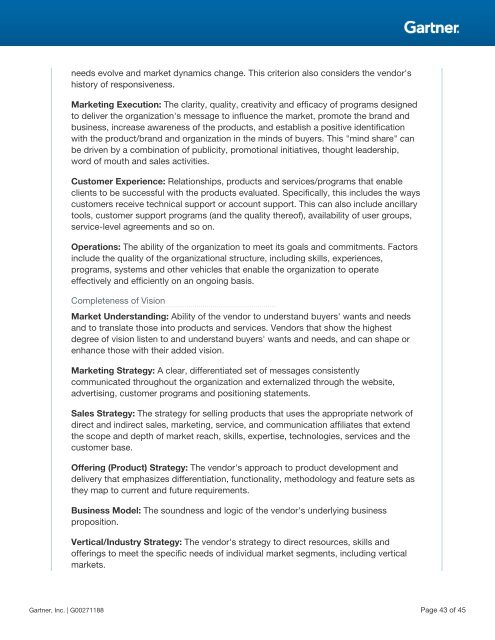Magic Quadrant for Enterprise Application Platform as a Service, Worldwide
Create successful ePaper yourself
Turn your PDF publications into a flip-book with our unique Google optimized e-Paper software.
needs evolve and market dynamics change. This criterion also considers the vendor's<br />
history of responsiveness.<br />
Marketing Execution: The clarity, quality, creativity and efficacy of programs designed<br />
to deliver the organization's message to influence the market, promote the brand and<br />
business, incre<strong>as</strong>e awareness of the products, and establish a positive identification<br />
with the product/brand and organization in the minds of buyers. This "mind share" can<br />
be driven by a combination of publicity, promotional initiatives, thought leadership,<br />
word of mouth and sales activities.<br />
Customer Experience: Relationships, products and services/programs that enable<br />
clients to be successful with the products evaluated. Specifically, this includes the ways<br />
customers receive technical support or account support. This can also include ancillary<br />
tools, customer support programs (and the quality thereof), availability of user groups,<br />
service-level agreements and so on.<br />
Operations: The ability of the organization to meet its goals and commitments. Factors<br />
include the quality of the organizational structure, including skills, experiences,<br />
programs, systems and other vehicles that enable the organization to operate<br />
effectively and efficiently on an ongoing b<strong>as</strong>is.<br />
Completeness of Vision<br />
Market Understanding: Ability of the vendor to understand buyers' wants and needs<br />
and to translate those into products and services. Vendors that show the highest<br />
degree of vision listen to and understand buyers' wants and needs, and can shape or<br />
enhance those with their added vision.<br />
Marketing Strategy: A clear, differentiated set of messages consistently<br />
communicated throughout the organization and externalized through the website,<br />
advertising, customer programs and positioning statements.<br />
Sales Strategy: The strategy <strong>for</strong> selling products that uses the appropriate network of<br />
direct and indirect sales, marketing, service, and communication affiliates that extend<br />
the scope and depth of market reach, skills, expertise, technologies, services and the<br />
customer b<strong>as</strong>e.<br />
Offering (Product) Strategy: The vendor's approach to product development and<br />
delivery that emph<strong>as</strong>izes differentiation, functionality, methodology and feature sets <strong>as</strong><br />
they map to current and future requirements.<br />
Business Model: The soundness and logic of the vendor's underlying business<br />
proposition.<br />
Vertical/Industry Strategy: The vendor's strategy to direct resources, skills and<br />
offerings to meet the specific needs of individual market segments, including vertical<br />
markets.<br />
Gartner, Inc. | G00271188 Page 43 of 45



